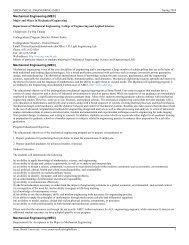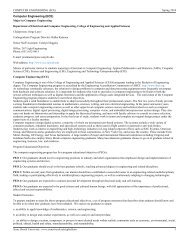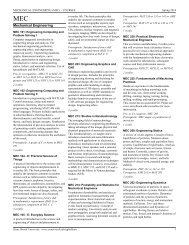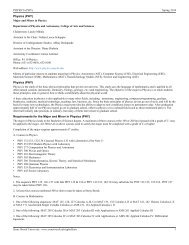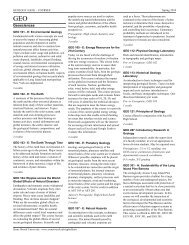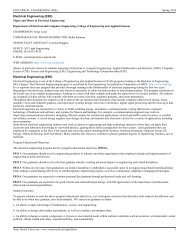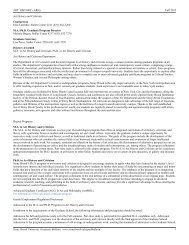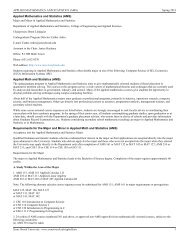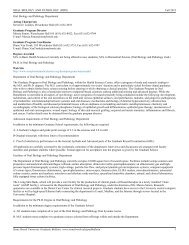Program PDF - Stony Brook University
Program PDF - Stony Brook University
Program PDF - Stony Brook University
Create successful ePaper yourself
Turn your PDF publications into a flip-book with our unique Google optimized e-Paper software.
COMPUTER ENGINEERING (ECE) Spring 2014<br />
Electrical and Computer Engineering Department<br />
Chairperson<br />
Serge Luryi, Light Engineering Building 273 (631) 632-8420<br />
Graduate <strong>Program</strong> Director<br />
Yuanyuan Yang, Light Engineering Building 215 (631) 632-8400/8397<br />
Senior Staff Assistant<br />
Deborah Kloppenburg, Light Engineering Building 273 (631) 632-8420<br />
Graduate <strong>Program</strong> Coordinator<br />
Rachel Ingrassia, Light Engineering Building 267A (631) 632-8400<br />
Degrees Awarded<br />
M.S. in Electrical Engineering; M.S. in Computer Engineering; Ph.D. in Electrical Engineering; Ph.D. in Computer Engineering<br />
Web Site<br />
http://www.ee.sunysb.edu/<br />
Electrical and Computer Engineering Department<br />
The fields of electrical and computer engineering are in an extraordinary period of growth; new application areas and increased expectations are<br />
accelerating due to new technologies and decreased costs. The Electrical and Computer Engineering Department, in the College of Engineering<br />
and Applied Sciences, is involved in graduate teaching and research in many of these areas, including communications and signal processing,<br />
networking, computer engineering, semiconductor devices and quantum electronics, circuits and VLSI. The department has laboratories<br />
devoted to research and advanced teaching in the following areas: computing, engineering design methodology, high-performance computing<br />
and networking, parallel and neural processing, machine vision, fiber optic sensors and computer graphics, micro and optoelectronics/VLSI,<br />
telerobotics, DNA sequencing, digital signal processing, and communications.<br />
Since Long Island contains one of the highest concentrations of engineering-oriented companies in the country, the department is particularly<br />
strongly committed to meeting the needs of local industry. As part of this commitment, most graduate courses are given in the late afternoon or<br />
evening, so as to be available to working engineers on Long Island.<br />
The value of this commitment to industry is evidenced by the support received by the department in return; in particular, from Motorola, Lucent<br />
Technologies, AT&T, Intel Corporation, and Texas Instruments.<br />
The Department of Electrical and Computer Engineering offers graduate programs leading to the M.S. and Ph.D. degrees. Graduate programs<br />
are tailored to the needs of each student to provide a strong analytical background helpful to the study of advanced engineering problems.<br />
Ample opportunities exist for students to initiate independent study and to become involved in active research programs, both experimental and<br />
theoretical.<br />
Areas of Emphasis in Graduate Study<br />
Areas of emphasis in current research and instruction are: Communications and Signal Processing, Computer Engineering, Semiconductor<br />
Devices and Quantum Electronics, Circuits and VLSI.<br />
Specialties that fall under one or more of the above categories include: VLSI, Image Processing, Computer Vision, Integrated Circuit Fabrication,<br />
Novel Electronic Devices, Digital Communication, Biomedical Electronics, Computer-Aided Design, Computer Networks, Parallel Processing,<br />
Fault-Tolerant Computing, Microprocessors, Robotics, Network Theory, and Optical Signal Processing and Fiber Optic Sensors. Theoretical and<br />
experimental programs reflecting these areas are currently underway and students are encouraged to actively participate in these efforts. Outlined<br />
below is an overview of the Department's research areas.<br />
Communications and Signal Processing<br />
Subject areas of current interest include mobile, wireless and personal communications; high speed data and computer communication networks;<br />
communications traffic; data compression; coding and modulation techniques; inter-connection networks and high speed packet switching; digital<br />
communication; detection and estimation; statistical signal processing; spectrum estimation; image analysis and processing; computer vision.<br />
Computer Engineering<br />
The goal of computer engineering in the ECE department is to provide a balance view of hardware and software issues. The expertise in the<br />
program include parallel and/or high performance computer architecture, embedded microprocessor system design, fault tolerant computing,<br />
design communications and signal processing, parallel and distributed computing, computer networks, computer vision, artificial neural networks<br />
and software engineering.<br />
Semiconductor Devices, Quantum Electronics<br />
The program of courses and of research pertinent to solid-state electronics, electromagnetics and optics ranges from a study of the fundamental<br />
electronic processes in solids and gases through a description of the mechanism which yield useful devices to a study of the design simulation,<br />
and fabrication of integrated circuits. <strong>Program</strong>’s scientific interests center on physics, characterization and development of optoelectronic<br />
devices and systems. Over the past several years, major efforts were focused on the studies of physics of semiconductor lasers and detectors.<br />
<strong>Stony</strong> <strong>Brook</strong> <strong>University</strong> Graduate Bulletin: www.stonybrook.edu/gradbulletin 1
COMPUTER ENGINEERING (ECE) Spring 2014<br />
Additionally, the department has a strong experimental effort on the development of coherent optical processors, fiber optic sensors and<br />
integrated fiber optics.<br />
Circuits and VLSI<br />
The program in the Circuits and VLSI area addresses problems associated to modeling, simulation, design and fabrication of analog, digital, and<br />
mixed-signal integrated circuits. Analog and mixed-mode integrated circuit (IC) devices have important applications in many fields including<br />
avionics, space technology, and medical technology. The department offers basic and advanced courses covering the following subjects:<br />
integrated circuit technology, device modeling, software tools for circuit design and simulation, analog circuit design, VLSI circuits, testing of<br />
analog and digital ICs, design automation for analog, digital and mixed-mode circuits, VLSI systems for communications and signal processing.<br />
Admission requirements of Electrical and Computer Engineering Department<br />
For admission to graduate study in the Department of Electrical and Computer Engineering, the minimum requirements are:<br />
A. A bachelor’s degree in electrical engineering from an accredited college or university. Outstanding applicants in other technical or scientific<br />
fields will be considered, though special make-up coursework over and above the normal requirements for a graduate degree may be required.<br />
B. A minimum grade point average of B in all courses in engineering, mathematics, and science.<br />
C. Official Results of the Graduate Record Examination (GRE) General Test.<br />
D. Acceptance by both the Department of Electrical and Computer Engineering and the Graduate School.<br />
Facilities of Electrical and Computer Engineering department<br />
The department operates laboratories for both teaching and research:<br />
The Advanced IC Design & Simulation Laboratory contains equipment and computing facilities for the design, simulation, and<br />
characterization of analog, digital and mixed-signal integrated circuits. The lab is equipped with several SUN workstations and PCs, and assorted<br />
electronic measurement equipment.<br />
The Communications, Signal Processing, Speech, and Vision (CSPV) Laboratory has several SUN workstations and desktop computers<br />
with specialized software for research in telecommunications networks and signal processing. The computers are networked to departmental<br />
computing facilities allowing access to shared campus resources and the Internet.<br />
The Computer-Aided Design Laboratory provides a network of 386 based workstations. Advanced computer-aided design software for analog<br />
and digital systems design is available on these workstations.<br />
The Computer Vision Laboratory has state-of-the-art equipment for experimental research in three-dimensional machine vision. The facilities<br />
include desktop computers, imaging hardware, and printers.<br />
The Digital Signal Processing Research Laboratory is involved in digital signal processing architectures and hardware and software research.<br />
The laboratory is presently active in the development of algorithms to be implemented on a variety of signal processing chips.<br />
The Fluorescence Detection Lab is involved in the design, development, implementation and testing of various DNA sequencing instruments.<br />
Research areas include laser induced fluorescence detection, single photon counting techniques, fast data acquisition and transfer, design and<br />
development of analog and digital integrated circuits, signal processing, capillary electrophoresis phenomena and DNA sequencing.<br />
The Graduate Computing Laboratory has 12 Windows 2000 Professional based Windows PC’s, equipped with Microsoft Office XP,<br />
Microsoft Visual Studio, X-Windows for Unix connectivity, Adobe Acrobat reader, Ghost script and Ghost view. There is an HP LaserJet 5Si/<br />
MX printer. The lab is also equipped with 8 Sun Blade 100 machines. These machines run Sun Solaris 8 operating systems and are connected to<br />
the departmental Unix servers. Industry standard packages such as Cadence tools, Synopsys, Hspice and Matlab are available from the application<br />
servers.<br />
The High Performance Computing and Networking Research Laboratory is equipped to conduct research in the broad area of networking<br />
and parallel/distributed computing with emphasis on wireless/mobile networks, cloud computing, data center networks, optical networks, highspeed<br />
networks, interconnection networks and multicast communication. The laboratory has 1 Dell PowerEdge 1800 computing server, 8 Dell<br />
OptiPlex GX620 MT workstations, 2 Sun Ultra 60 Workstations with dual processors, and 4 Sun Ultra 10 Workstations.<br />
The Medical Image Processing Laboratory, located in the medical school, is involved in research in image reconstruction methods and image<br />
analysis with applications to medical imaging It is equipped with a SUN SPARC l0, SPARC 2, HP730 workstations and a full complement of<br />
peripherals.<br />
The Optical Signal Processing and Fiber Optic Sensors Laboratory research emphasis is on the development and fabrication of novel fiber<br />
optic systems for very diverse applications ranging from aerospace to biomedical projects involving the development of new techniques and<br />
algorithms. Some of the current research projects include development capillary waveguide based biosensors for detection of pathogens in a<br />
marine environment, integrated fiber optic based systems for real time detection of synchronous and asynchronous vibrations in turbomachinery,<br />
and single photon based detection schemes for sub-microscopic particle sizing. Equipment includes a fiber optic fusion splicer, fiber polisher,<br />
diamond saw, optical microscope, optical spectrometer (visible range), micropositioners, optical scanners, and various laser sources. Additionally,<br />
the laboratory has the facilities for designing printed circuits and fabricating optical and electronic sub-systems. Some of the current research<br />
projects include development of fiber optic systems for real time process control in adverse environments, integrated fiber optics, fiber optic<br />
sensors and coherent optical processing.<br />
<strong>Stony</strong> <strong>Brook</strong> <strong>University</strong> Graduate Bulletin: www.stonybrook.edu/gradbulletin 2
COMPUTER ENGINEERING (ECE) Spring 2014<br />
The Parallel and Neural Processing Laboratory conducts research in various parallel and neural network applications. Current research<br />
projects include Natural Adaptive Critic control, pattern recognitions and Bayesian Neural Networks. It is equipped with Pentium PCs and<br />
Synapse3 parallel neural network processing boards.<br />
The Petaflops Design Laboratory is a research facility equipped with two SUN workstations, several PC’s with Linex, and a 16-process<br />
Beowulf-type cluster. All computes are connected by Fast 100 Mb/sec Ethernet LAN.<br />
The Semiconductor Optoelectronics Laboratory possesses the infrastructure for wafer processing, testing and sophisticated characterization<br />
of optoelectronics devices. Processing facilities are based on a “Class 100” clean room with Darl Suss aligner, Temescal metal film deposition<br />
system and other equipment required for modern semiconductor wafer processing. Wafer testing can be performed by low and high temperature<br />
probe-stations. Characterization of devices after processing includes electrical, optical and spectral measurements. Electrical and optical<br />
measurements can be carried out within a wide frequency range from CW to 22GHz. Semiconductor laser near and far field emission patterns can<br />
be studied in a wide spectral range from visible to mid-infrared. Spectral analysis of radiation is performed with high resolution and sensitivity<br />
using grating and two Fourier transform spectrometers in combination with state-of-the-art detector systems. Time resolved luminescence<br />
experiments are available with ns resolution. The laboratory is equipped with 150fs Nd-glass mode locked laser for optical pumping as well<br />
as other pump sources including a high energy Q-switched Nd solid-state laser. New experimental methods of studying semiconductor laser<br />
parameters, developed in the Laboratory, include direct heterobarrier leakage current measurements as well as gain, loss and alpha-factor<br />
measurements in broad area and single mode lasers.<br />
Requirements for the M.S. Degree in Electrical and Computer Engineering<br />
The M.S. degree in the Department of Electrical and Computer Engineering requires the satisfactory completion of a minimum of 30 graduate<br />
credits. These requirements may be satisfied by either one of the four following options:<br />
Any non-ESE course will need prior approval given by the Graduate <strong>Program</strong> Director before a student can register.<br />
I. M.S. in Electrical Engineering Non-Thesis Option<br />
1. At least 30 graduate credits with a cumulative and departmental grade point average of 3.0 or better. Among these 30 credits, up to six credits<br />
may be ESE 597, ESE 599, or ESE 698<br />
PLEASE NOTE: Only 3 credits of ESE 698 may be used in above.<br />
2. A minimum of eight regular courses. Of these eight, at least seven regular courses must be taken in the department; three of the seven must be<br />
selected from the following CORE Courses: ESE 502, ESE 503, ESE 511, ESE 520, ESE 528 or ESE 532, ESE 545, ESE 554, and ESE 555.<br />
3. ESE 597, ESE 599, ESE 697, ESE 698 and ESE 699 are not counted as regular courses in (2). Also our Topics course, ESE 670, can be<br />
counted only once as a regular course credit toward the M.S. degree. Credits for ESE 597 can only be applied toward the electrical engineering<br />
degree if the following requirements are satisfied:<br />
Prior approval from the Graduate <strong>Program</strong> Director based on the student submitting a proposal and securing an advisor in the ECE department as<br />
well as a contact person at the company involved. Approval will only be granted if it can be demonstrated that the faculty advisor will be kept in<br />
close touch with work on the project. To this end, practicum not in the local geographic area will be discouraged.<br />
To obtain satisfactory credit the faculty advisor must verify that a substantial engineering project was undertaken and completed. This will be<br />
based on his close contact during the entire period of the project with the student and the contact person and upon reviewing a mandatory written<br />
report submitted by the student at the project's completion. The faculty advisor will determine the final grade for the course.<br />
A candidate for the master’s degree may petition to transfer a maximum of 12 graduate credits from another institution towards the master’s<br />
degree requirements. Students transferring from non-matriculated status are also limited to a maximum of 12 credits for the master’s degree.<br />
II. M.S. in Electrical Engineering Thesis Option<br />
Students must inform the department in writing at the end of their first semester if they choose the M.S. Thesis Option.<br />
1. At least 30 graduate credits with a cumulative and departmental grade point average of 3.0 or better. Among these 30 credits, at least six credits<br />
of ESE 599, with a maximum of 12 credits total being taken from ESE 599, ESE 597, or ESE 698.<br />
PLEASE NOTE: Only 3 credits of ESE 698 may be used in above.<br />
2. Minimum of six (6) regular courses. Of these six, at least five (5) regular courses must be taken in the department. Three of these five regular<br />
courses must be selected from the following CORE Courses: ESE 502, ESE 503, ESE 511, ESE 520, ESE 528 or ESE 532, ESE 545, ESE 554,<br />
and ESE 555.<br />
3. ESE 597, ESE 599, ESE 697, ESE 698 and ESE 699 are not counted as regular courses in (2). Also our Topics course, ESE 670, can be<br />
counted only once as a regular course credit toward the M.S. degree. Credits for ESE 597 can only be applied toward the electrical engineering<br />
degree if the following requirements are satisfied:<br />
Prior approval from the Graduate <strong>Program</strong> Director based on the student submitting a proposal and securing an advisor in the ECE department as<br />
well as a contact person at the company involved. Approval will only be granted if it can be demonstrated that the faculty advisor will be kept in<br />
close touch with work on the project. To this end, practicum not in the local geographic area will be discouraged.<br />
<strong>Stony</strong> <strong>Brook</strong> <strong>University</strong> Graduate Bulletin: www.stonybrook.edu/gradbulletin 3
COMPUTER ENGINEERING (ECE) Spring 2014<br />
To obtain satisfactory credit the faculty advisor must verify that a substantial engineering project was undertaken and completed. This will be<br />
based on his close contact during the entire period of the project with the student and the contact person and upon reviewing a mandatory written<br />
report submitted by the student at the project's completion. The faculty advisor will determine the final grade for the course.<br />
A candidate for the master’s degree may petition to transfer a maximum of 12 graduate credits from another institution towards the master’s<br />
degree requirements. Students transferring from non-matriculated status are also limited to a maximum of 12 credits for master’s degrees.<br />
Students must satisfactorily complete a thesis.<br />
I. Computer Engineering Non-Thesis Option<br />
Admission to the M.S. program in Computer Engineering requires the student to have completed a Bachelor degree in Computer Engineering or<br />
Computer Science. Students with a Bachelor degree in Electrical Engineering could also be admitted if they have taken or will take the following<br />
courses or their equivalent:<br />
ESE 345 Computer Architecture<br />
ESE 380 Embedded Microprocessor Systems Design I<br />
ESE 333 Real-Time Operating Systems<br />
All non-ESE courses that are not on the pre-approved departmental list that you wish to use toward your degree must receive prior approval from<br />
the Graduate <strong>Program</strong> Director.<br />
The courses listed below can only be used once to satisfy the degree requirements::<br />
Computer Hardware: One course from the following:ESE/CSE 536 Switching and Routing in Parallel and Distributed Systems, ESE 545<br />
Computer Architecture, ESE 565 Parallel Processing Architectures, ESE 566 Hardware-Software Co-Design of Embedded Systems, ESE 580<br />
Microprocessor-Based Systems I, ESE 581 Microprocessor-Based Systems II.<br />
At least three Computer Engineering courses with at least one course from each of the following three sub-areas:<br />
Networking: ESE 505 Wireless Network, ESE 506 Wireless Networking and Mobile Computing, ESE 546 Computer Communication Networks,<br />
ESE 548 Local & Wide Area Networks, and ESE 550 Network Management and Planning.<br />
CAD and VLSI: ESE 530 Computer Aided Design, ESE 549 Advanced VLSI System Testing, ESE 555 Advanced VLSI Circuit Design, ESE<br />
556 VLSI Physical and Logic Design Automation, ESE 575 Advanced VLSI Signal Processing Architecture.<br />
Theory: ESE 554 Computational Models for Computer Engineers, CSE 548/AMS 542 Analysis of Algorithms.<br />
At least one software course: ESE 568 Computer and Robot Vision, ESE 588 Pattern Recognition, CSE 504 Compiler Design, CSE 506<br />
Operating Systems, CSE 526 Principles of <strong>Program</strong>ming Languages, CSE 533 Network <strong>Program</strong>ming, CSE 548/AMS 542 Analysis of<br />
Algorithms.<br />
Up to six credits may be from ESE 597, ESE 599, or ESE 698 (only 3 credits of ESE 698 may be used)<br />
ESE 597, ESE 599, ESE 697, ESE 698 and ESE 699 are not counted as regular courses.<br />
Also our Topics course, ESE 670, can be counted only once as a regular course credit toward the M.S. degree. Credits for ESE 597 can only be<br />
applied toward the Computer Engineering degree if the following requirements are satisfied:<br />
Prior approval from the Graduate <strong>Program</strong> Director based on the student submitting a proposal and securing an advisor in the ECE department as<br />
well as a contact person at the company involved. Approval will only be granted if it can be demonstrated that the faculty advisor will be kept in<br />
close touch with work on the project. To this end, practicum not in the local geographic area will be discouraged.<br />
To obtain satisfactory credit the faculty advisor must verify that a substantial engineering project was undertaken and completed. This will be<br />
based on his close contact during the entire period of the project with the student and the contact person and upon reviewing a mandatory written<br />
report submitted by the student at the project's completion. The faculty advisor will determine the final grade for the course.<br />
A candidate for the master’s degree may petition to transfer a maximum of 12 graduate credits from another institution towards the master’s<br />
degree requirements. Students transferring from non-matriculated status are also limited to a maximum of 12 credits for the master’s degree.<br />
II. Computer Engineering Thesis Option<br />
Students must inform the department in writing at the end of their first semester if they choose the M.S. Thesis Option.<br />
All non-ESE courses that are not on the pre-approved departmental list that you wish to use toward your degree must receive prior approval from<br />
the Graduate <strong>Program</strong> Director.<br />
The M.S. degree with thesis option requires at least 30 graduate credits with a cumulative and departmental grade point average of 3.0 or better.<br />
Among these 30 credits, at least six credits of ESE 599, with a maximum of 12 credits total being taken from ESE 597, ESE 599, or ESE 698.<br />
PLEASE NOTE: Only 3 credits of ESE 698 may be used in above.<br />
The courses listed below can only be used once to satisfy the degree requirements:<br />
<strong>Stony</strong> <strong>Brook</strong> <strong>University</strong> Graduate Bulletin: www.stonybrook.edu/gradbulletin 4
COMPUTER ENGINEERING (ECE) Spring 2014<br />
Computer Hardware: One course from the following; ESE/CSE 536 Switching and Routing in Parallel and Distributed Systems, ESE 545<br />
Computer Architecture, ESE 565 Parallel Processing Architectures, ESE 566 Hardware-Software Co-Design of Embedded Systems, ESE 580<br />
Microprocessor-Based Systems I, ESE 581 Microprocessor-Based Systems II.<br />
At least three Computer Engineering courses with at least one course from each of the following three sub-areas:<br />
Networking: ESE 505 Wireless Network, ESE 506 Wireless Networking and Mobile Computing, ESE 546 Computer Communication Networks,<br />
ESE 548 Local & Wide Area Networks, and ESE 550 Network Management and Planning.<br />
CAD and VLSI: ESE 530 Computer Aided Design, ESE 549 Advanced VLSI System Testing, ESE 555 Advanced VLSI Circuit Design, ESE<br />
556 VLSI Physical and Logic Design Automation, ESE 575 Advanced VLSI Signal Processing Architecture.<br />
Theory: ESE 554 Computational Models for Computer Engineers, CSE 548/AMS 542 Analysis of Algorithms .<br />
At least one Software course: ESE 568 Computer and Robot Vision, ESE 588 Pattern Recognition, CSE 504 Compiler Design, CSE 506<br />
Operating Systems, CSE 526 Principles of <strong>Program</strong>ming Languages, CSE 533 Network <strong>Program</strong>ming, CSE 548/AMS 542 Analysis of<br />
Algorithms.<br />
At least one additional regular course offered by the ECE department.<br />
ESE 597, ESE 599, ESE 697, ESE 698, and ESE 699 are not counted as regular courses.<br />
Also our Topics course, ESE 670, can be counted only once as a regular course credit toward the M.S. degree. Credits for ESE 597 can only be<br />
applied toward the Computer Engineering degree if the following requirements are satisfied:<br />
Prior approval from the Graduate <strong>Program</strong> Director based on the student submitting a proposal and securing an advisor in the ECE department as<br />
well as a contact person at the company involved. Approval will only be granted if it can be demonstrated that the faculty advisor will be kept in<br />
close touch with work on the project. To this end, practicum not in the local geographic area will be discouraged.<br />
To obtain satisfactory credit the faculty advisor must verify that a substantial engineering project was undertaken and completed. This will be<br />
based on his close contact during the entire period of the project with the student and the contact person and upon reviewing a mandatory written<br />
report submitted by the student at the project's completion. The faculty advisor will determine the final grade for the course.<br />
A candidate for the master’s degree may petition to transfer a maximum of 12 graduate credits from another institution towards the master’s<br />
degree requirements. Students transferring from non-matriculated status are also limited to a maximum of 12 credits for master’s degrees.<br />
Requirements for the Ph.D. Degree in Electrical and Computer Engineering<br />
A. Qualifying Examination<br />
There is a major and minor part to the qualifying examination. The written examination is offered once every year, in April. Students must pass<br />
one major written examination in two consecutive tries. The two consecutive tries do not need to be in the same area. The minor requirement<br />
can be satisfied by taking and passing a second major written examination or by taking three graduate courses in a different area than the major.<br />
Previous examinations are available in the departmental office for review, however, students must make their own copies. Please refer to the<br />
department’s Graduate Student Guide for additional information on the qualifying examination.<br />
B. Course Requirements<br />
1. A minimum of six regular courses beyond the M.S. degree or 14 regular courses beyond the bachelor’s degree. The choice must have the prior<br />
approval of the designated faculty academic advisor. ESE 697 Practicum in Teaching (3 credits) is required to satisfy the teaching requirement.<br />
Students must be G-5 status in order to take this course. The courses ESE 597, ESE 598, ESE 599, ESE 698, and ESE 699 are not counted as<br />
regular courses. Courses presented under the title ESE 670 Topics in Electrical Sciences that have different subject matters, and are offered as<br />
formal lecture courses, are considered different regular courses but may not be counted more than once as a regular course for credit toward the<br />
M.S. degree, and not more than twice for all graduate degrees awarded by the Department of Electrical and Computer Engineering.<br />
2. The student must satisfy the stipulations of a plan of study which must be filed with the graduate program committee within six months after<br />
the student passes the qualifying examination. The study plan, which will include the six regular courses as required in item 1, will be developed<br />
under the aegis of the designated faculty advisor (who may or may not be the eventual thesis advisor). Modification of the study plan may be<br />
made by the preliminary examination committee and at any later time by the thesis advisor. An up-to-date plan must always be placed on file with<br />
the graduate program committee each time a modification is made.<br />
C. Preliminary Examination<br />
A student must pass the preliminary examination within 3 years of passing the qualifying examination. Both a thesis topic and the thesis<br />
background area are emphasized.<br />
D. Advancement to Candidacy<br />
After successfully completing all requirements for the degree other than the dissertation, the student is eligible to be recommended for<br />
advancement to candidacy. This status is conferred by the dean of the Graduate School upon recommendation from the chairperson of the<br />
department. Students must advance advance to candidacy and pass the PreliminaryExam at least one year prior to the dissertation defense.<br />
E. Dissertation<br />
<strong>Stony</strong> <strong>Brook</strong> <strong>University</strong> Graduate Bulletin: www.stonybrook.edu/gradbulletin 5
COMPUTER ENGINEERING (ECE) Spring 2014<br />
The most important requirement for the Ph.D. degree is the completion of a dissertation, which must be an original scholarly investigation. The<br />
dissertation must represent a significant contribution to the scientific and engineering literature, and its quality must be compatible with the<br />
publication standards of appropriate and reputable scholarly journals.<br />
F. Approval and Defense of Dissertation<br />
The dissertation must be orally defended before a dissertation examination committee, and the candidate must obtain approval of the dissertation<br />
from this committee. The committee must have a minimum of four members (at least three of whom are faculty members from the department),<br />
including the research advisor, at least one person from outside the department, and a committee chair. (Neither the research advisor nor the<br />
outside member may serve as the chair). On the basis of the recommendation of this committee, the dean of engineering and applied sciences will<br />
recommend acceptance or rejection of the dissertation to the dean of the Graduate School. All requirements for the degree will have been satisfied<br />
upon the successful defense of the dissertation.<br />
G. Residency Requirement<br />
The student must complete two consecutive semesters of full-time graduate study. Full-time study is 12 credits per semester until 24 graduate<br />
credits have been earned. After 24 graduate credits have been earned, the student may take only nine credits per semester for full-time status.<br />
H. Time Limit<br />
All requirements for the Ph.D. degree must be completed within seven years after completing 24 credits of graduate courses in the department.<br />
Faculty of Electrical and Computer Engineering Department<br />
Distinguished Professors<br />
Belenky, Gregory, Doctor of Physical and Mathematical Sciences, 1979, Institute of Physics, Baku, USSR: Design, manufacturing, and<br />
characterization of optoelectronic and microelectronic semiconductor devices; physics of semiconductors and semiconductor devices.<br />
Luryi, Serge, Chairperson. Ph.D., 1978, <strong>University</strong> of Toronto, Canada: High speed solid-state electronic and photonic devices, physics and<br />
technology..<br />
Professors<br />
Djuric, Petar M., Ph.D., 1990, <strong>University</strong> of Rhode Island: Signal analysis, modeling and processing; wireless communications and sensor<br />
networks.<br />
Hong, Sangjin, Ph.D., 1999, <strong>University</strong> of Michigan: Low-power VLSI design of multimedia wireless communications and digital signal<br />
processing systems, including SOC design methodology and optimization.<br />
Parekh, Jayant P., Ph.D., 1971, Polytechnic Institute of <strong>Brook</strong>lyn: Microwave acoustics; microwave magnetics; microwave electronics;<br />
microcomputer applications.<br />
Robertazzi, Thomas G., 1981, Princeton <strong>University</strong>: Computer communications; performance evaluation; parallel processing; e-commerce<br />
technology.<br />
Shamash, Yacov, Dean of the College of Engineering and Applied Sciences. Ph.D., 1973, Imperial College of Science and Technology, England:<br />
Control system; robotics.<br />
Short, Kenneth L., Ph.D., 1973, <strong>University</strong> at <strong>Stony</strong> <strong>Brook</strong>: Digital system design; microprocessors; instrumentation.<br />
Subbarao, Murali, Ph.D., 1986, <strong>University</strong> of Maryland: Machine vision; image processing; pattern recognition.<br />
Yang, Yuanyuan, Graduate <strong>Program</strong> Director. Ph.D., 1992, Johns Hopkins <strong>University</strong>: Wireless and mobile networks, cloud computing, data<br />
center networks, optical networks, high speed networks, parallel and distributed computing systems, multicast communication, high performance<br />
computer architecture, and computer algorithms.<br />
Associate Professors<br />
Dhadwal, Harbans, Ph.D., 1980, <strong>University</strong> of London, England: Laser light scattering; fiber optics; optical signal processing and<br />
instrumentation.<br />
Doboli, Alex, Ph.D., 2000, <strong>University</strong> of Cincinnati: VLSI CAD and design, synthesis and simulation of mixed analog-digital systems, hardware/<br />
software co-design of embedded systems, and high-level synthesis of digital circuits.<br />
Donetski, Dmitri, Ph.D.. 2000, <strong>Stony</strong> <strong>Brook</strong> <strong>University</strong>: Design and technology of optoelectronic devices and systems including photovoltaic and<br />
photoconductive detectors, diode lasers and diode laser arrays.<br />
Dorojevets, Mikhail, Ph.D., 1988 Siberian Division of the USSR Academy of Sciences, Novosibirsk: Computer architectures, systems design.<br />
Fernandez-Bugallo, Monica, Ph.D., 2001, Universidade da Coruna (Spain): Statistical signal processing with emphasis in the topics of Bayesian<br />
analysis, sequential Monte Carolo methods, adaptive filtering, and stochastic optimization.<br />
<strong>Stony</strong> <strong>Brook</strong> <strong>University</strong> Graduate Bulletin: www.stonybrook.edu/gradbulletin 6
COMPUTER ENGINEERING (ECE) Spring 2014<br />
Gindi, Gene, Ph.D., 1981, <strong>University</strong> of Arizona: Medical image processing; image analysis.<br />
Gorfinkel, Vera, Ph.D., 1980, A.F. Iaffe Physical-Technical Institute, St. Petersburg, Russia: Semiconductor devices, including microwave and<br />
optoelectronics, DNA sequencing instrumentation, single<br />
photon counting techniques.<br />
Kamoua, Ridha, Ph.D., 1992, <strong>University</strong> of Michigan: Solid-state devices and circuits; microwave devices and integrated circuits.<br />
Murray, John, Ph.D., 1974, <strong>University</strong> of Notre Dame: Signal processing; systems theory.<br />
Stanacevic, Milutin, Ph.D., 2005, Johns Hopkins <strong>University</strong>: Analog and mixed-signal VLSI integrated circuits and systems; adaptive<br />
Microsystems; implantable electronics.<br />
Tang, K. Wendy, Ph.D., 1991, <strong>University</strong> of Rochester: Interconnection networks, parallel computing, and neural networks.<br />
Wang, Xin, Ph.D., 2001, Columbia <strong>University</strong>, Mobile and ubiquitous computing, wireless communications and networks, grid and distributed<br />
computing, advanced applications and services over Internet and wireless networks.<br />
Assistant Professors<br />
Milder, Peter, Ph.D. 2010, Carnegie –Mellon <strong>University</strong>, Digital hardware design, generation, and optimization focusing on signal processing,<br />
computer vision, and related domains; design for FPGA.<br />
Salman, Emre, Ph.D. 2009, <strong>University</strong> of Rochester, Nanoscale integrated circuit design, emerging technologies for future electronic systems,<br />
highly heterogeneous integrated systems, digital and mixed-signal circuits.<br />
Shterengas, Leon, Ph.D. 2004, <strong>Stony</strong> <strong>Brook</strong> <strong>University</strong>, High power and high speed light emitters, carrier dynamics in nanostructures, molecular<br />
beam epitaxy of semiconductor nanostructures.<br />
Westerfeld, David, Ph.D. 2005, <strong>Stony</strong> <strong>Brook</strong> <strong>University</strong>, Design and characterization of high-performance mid-infared semiconductor light<br />
sources (LEDs and lasers)<br />
Number of teaching, graduate, and research assistants, fall 2011: 60<br />
NOTE: The course descriptions for this program can be found in the corresponding program <strong>PDF</strong> or at COURSE SEARCH.<br />
<strong>Stony</strong> <strong>Brook</strong> <strong>University</strong> Graduate Bulletin: www.stonybrook.edu/gradbulletin 7



